This document covers the following topics:
This section provides common use cases of the basic concept of EntireX - achieving highly flexible interoperability of distributed application components. Each use case contains a
business scenario
table of interoperability, listing the major components selected for the use case
diagram of the type of message flow resulting from the combination of these specific components
stepped table describing the message flow depicted in the diagram.
The common use cases based on the EntireX components Broker and Developer's Kit are provided to show the extent and limitations of the EntireX Broker.
The Developer's Kit contains a set of interfaces for using applications written in various programming languages with EntireX Broker. Developer's Kit enables application components to be "wrapped", i.e. encapsulated, thereby allowing them to behave like an object and be plugged-and-played as needed.
The ACI forms the layer upon which the various wrappers of the Developer's Kit logically exist. This allows application programs to directly utilize the following industry-standard APIs that are exposed through the Developer's Kit and EntireX Broker.
The common use cases in the table below are specific examples of how EntireX Broker provides highly flexible interoperability of application components in a distributed processing environment. The programming interfaces selected for the use cases below are organized by the two communication models exposed through EntireX Broker: client and server and publish and subscribe.
| Case | Client | Server | Typical Use |
|---|---|---|---|
| Case 1 | ACI | ACI | To integrate applications on separate platforms. (Persistent messaging is described.) |
| Case 2 | JACI | ACI | To integrate applications on separate platforms, whereby the client's application interface is a subset of the ACI. |
| Case 3 | ACI (via Web server) | ACI | To enable Web access to mainframe systems. |
| Case 4 | RPC | RPC | To enable a UNIX or Windows application to access a Natural RPC program. |
| Case | Publish | Subscribe | Typical Use |
| Case 5 | ACI | ACI | To enable a mainframe application to publish messages to UNIX or Windows subscribers. |
This case is typically used to integrate applications on separate platforms.
An insurance company sells its own products as well as those of other insurers. It is company policy for its sales agents to give the most competitive insurance quotes possible to customers. The front-ends used by the sales agent are provided with GUI applications on Windows. To obtain insurance quotes from the back-end data as well as to update those data, the insurance agents must communicate information from/to various mainframe applications written in COBOL and PL/I.
| Application Component |
Programming Interface | EntireX Component | Operating System | Language | Messaging Model |
|---|---|---|---|---|---|
| Client | ACI | Broker | Windows | Visual C |
|
| Server | ACI | z/OS | COBOL, PL/I |
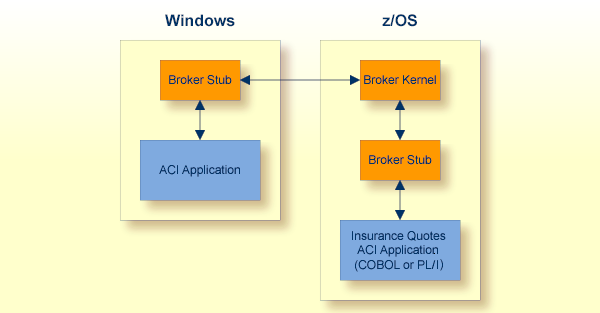
Synchronous
The client program creates a request for information from a
mainframe back-end and issues a call via the Broker stub to EntireX Broker.
With conversational communication, a series of linked requests can be issued, allowing both the client and server to retain context between commands.
The client program wants to communicate updated information to
the back-end system. It formulates one or more messages within a
unit of work (UOW)
and performs an asynchronous
SEND
from the stub to the broker.
The Broker writes the UOW to the persistent store, enabling the client program to know that the UOW will be processed.
Synchronous
The server application issues an ACI call via the Broker stub in
order to obtain the request from the client program.
Asynchronous
The server application issues a
RECEIVE
command, now or at a later time, in order to obtain the messages from the
client program.
Synchronous
The server application processes the request and returns a
message to EntireX Broker via the Broker stub.
Asynchronous
The server program performs processing to update the data on the
back-end system and, only afterwards does it acknowledge that the message has
been processed.
Synchronous
The client program receives the reply to the ACI call, allowing
the request to be satisfied.
Asynchronous
The client program can query the status of its messages by
UOWID in order to determine
the status of the back-end processing.
This case is typically used to integrate applications on separate platforms.
An organization wants to integrate a UNIX-based stock control system with its existing mainframe-based manufacturing planning systems.
| Architecture | Programming Interface | EntireX Component | Operating System | Language | Messaging Model |
|---|---|---|---|---|---|
| Client | JACI | Broker | UNIX | Java |
|
| Server | ACI | z/OS | Natural |
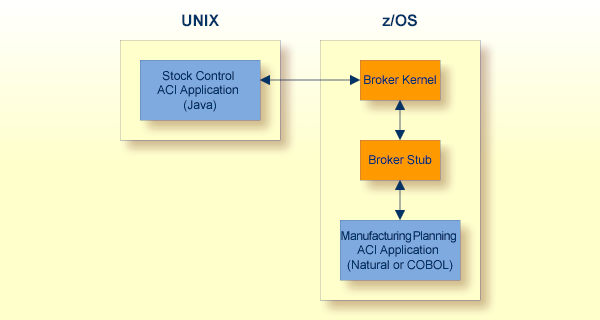
The client program creates a request and issues a JACI call to EntireX Broker.
The server application issues an ACI call via the Broker stub in order to obtain the request from the client program.
The server application processes the request and returns a message to EntireX Broker via the Broker stub.
The client program receives the reply to the ACI call, allowing the request to be satisfied.
This case is typically used to enable Web access to mainframe systems.
A brokerage has an application which processes orders of personal customers to buy and sell securities. All incoming orders are executed on a back-end system, and some orders are executed at a later time. The incoming orders are in the form of internet communication.
The brokerage uses a Web server as the point-of-entry for incoming orders. These orders are executed either synchronously or asynchronously on a separate back-end system. Located on the brokerage's Web server is an application which is a client to EntireX, which functions as a proxy and provides information to the brokerage's EIS (Enterprise Information System). Because of the critical nature of the orders, units of work are employed to guarantee delivery of the incoming information to the back-end system. This system is robust and can be restarted after failure without loss of data.
| Architecture | Programming Interface | EntireX Component | Operating System | Language | Messaging Model |
|---|---|---|---|---|---|
| Client | JACI | Broker | UNIX | Java Servlet |
|
| Server | ACI | z/OS | Natural |
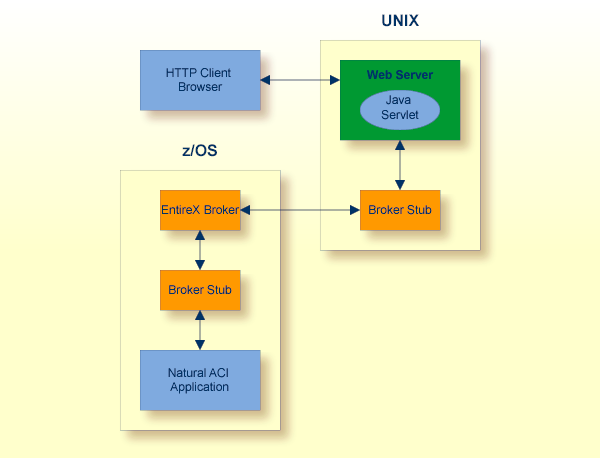
The Web browser sends an HTTP request to the Web server.
The Web server instantiates a Web page containing the script (ASP).
The script creates a request and issues an ACI call via the Broker stub to EntireX Broker.
The back-end application issues an ACI call via the Broker stub in order to obtain the request from the script.
The back-end application processes the request and returns a message to EntireX Broker via the Broker stub.
The script receives the reply to the ACI call, allowing the execution of the Web page to be completed.
The Web server returns the information to the Web browser via HTTP, where the Web page is displayed.
This case is typically used to enable a UNIX or Windows application to access a Natural RPC program.
Note:
This use case is the most common within EntireX; it employs
the EntireX Broker together with the Developer's Kit.
An organization actively using Software AG technology - including Adabas and Natural - wants to expand use of Software AG technology in order to build new applications accessible to clients executing under UNIX or Windows. To achieve this, the organization runs a client written to use RPC, which makes calls to EntireX Broker. The client, which is written in either Natural, Java or a 3GL language, will invoke any of these three variants:
(A)
RPC programs written in Natural and executing under Natural on z/OS
(RPC is available through Natural on z/OS);
(B)
RPC programs written in Java and executing under the
Java RPC Server on UNIX;
(C)
3GL RPC programs executing under the C RPC Server on
Windows.
| Application Component | Programming Interface | EntireX Component | Operating System | Language * | Messaging Model | |
|---|---|---|---|---|---|---|
| (A) | Client | RPC | EntireX Broker and Developer's Kit | C | Visual Basic |
|
| Server | RPC | z/OS | Natural | |||
| (B) | Client | RPC | Windows | Natural | ||
| Server | RPC | UNIX | Java | |||
| (C) | Client | RPC | UNIX | Java | ||
| Server | RPC | Windows | C (=3GL) | |||
This diagram represents variant (A) in Table of Interoperability above.
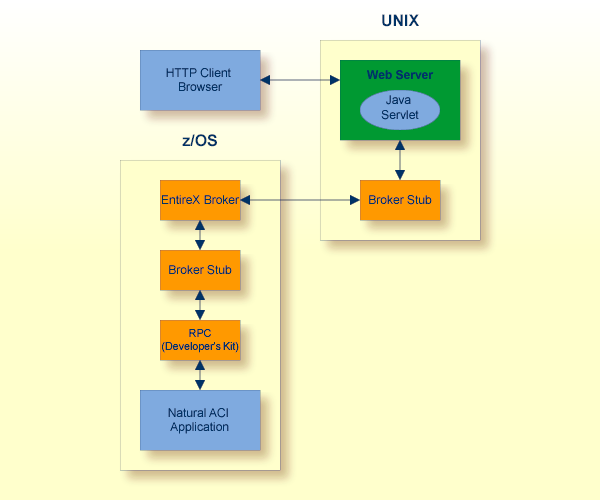
The client application ACI application initiates an RPC request through the SDK: synchronous/conversational or synchronous/non-conversational.
Broker stub communicates this request to the broker kernel.
Natural
The broker kernel communicates this request to Natural nucleus,
which behaves like an RPC server for Natural-written applications programs.
Java
Broker communicates this request to RPC server.
C
Broker communicates this request to RPC server.
Natural
Natural nucleus invokes the RPC server program.
Java
RPC server invokes the server application program.
C
RPC server invokes the server application program.
Natural
Natural nucleus returns the request to EntireX Broker.
Java
RPC server returns the request to EntireX Broker.
C
RPC server returns the request to EntireX Broker.
Broker passes the request to the ACI application.
This case is typically used to enable a mainframe application to publish messages to UNIX or Windows subscribers.
A government department publishes details of various construction projects for which contractors are required. Companies are then able to bid for the contracts.
The government application consists of two pieces: a publisher and a subscriber component. An application running on z/OS publishes details for each new construction project. Publications are sent asynchronously with a logical topic name in accordance with the type of construction project required, for example freeways, minor roads, bridges. Approved contractors are given access to the subscriber component of the application which runs under Windows. Here the contractors can subscribe to the project types of interest and can receive details of projects for the specified project types at their convenience.
| Architecture | Programming Interface | EntireX Component | Operating System | Language | Messaging Model |
|---|---|---|---|---|---|
| Publisher | ACI | Broker | z/OS | Natural |
|
| Subscriber | ACI | Windows | Visual C |
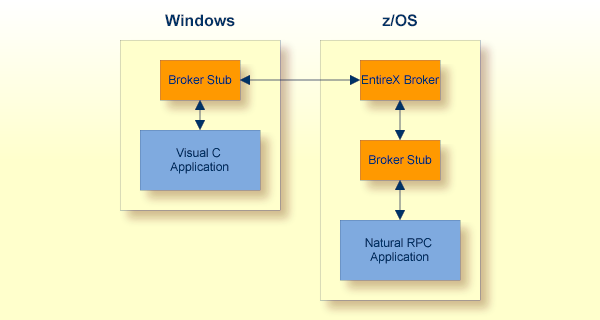
The publisher component is executed when new publication messages are to be sent, using an ACI call via the Broker Stub to EntireX Broker.
EntireX Broker stores these publication messages into the persistent store, where they are available after a system restart.
The subscriber component is executed asynchronously, issuing an ACI call via the Broker stub to obtain published messages from EntireX Broker.
The subscriber repeats step (3) until all published messages have been received.